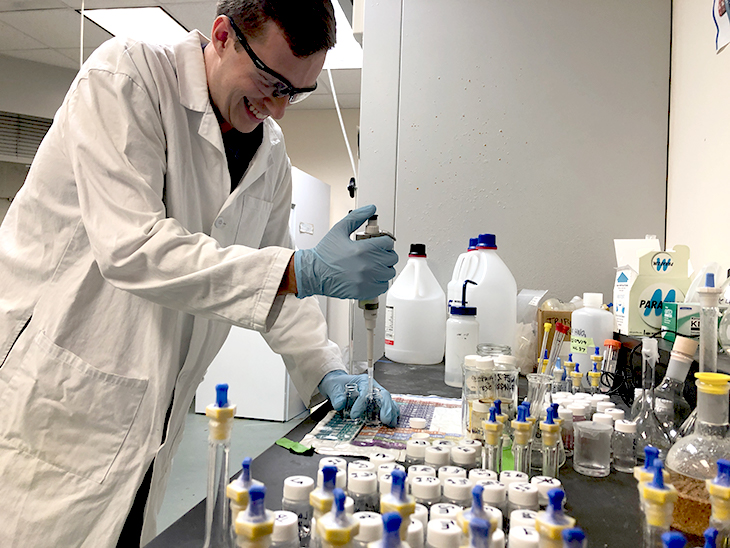Contact us
401 W. Kennedy Blvd.
Tampa, FL 33606-13490
(813) 253-3333
A typical day in the lab for Wyatt Larrinaga ’21 involves wearing a white lab coat and protective goggles, doing lots of mixing and stirring, and utilizing pipettes and round-bottom flasks.

“I definitely think this research experience has pushed me to be more of a progressive student,” said Wyatt Larrinaga ’21.
Larrinaga has been working with Eric Werner, associate professor of chemistry and chair of the Department of Chemistry, Biochemistry and Physics, since Fall 2018. Werner is an inorganic chemist who works with lanthanides, which are a group of metallic chemical elements that are part of a larger group of metals known as the rare earth elements. Werner’s research has focused on the different applications and properties of the lanthanides, such as luminescence.
Larrinaga wanted to get involved with research from the beginning of his UT career, but the opportunity hadn’t arisen organically. His student lab mentor, Nichole Laggan ’18, had told him all about the research she was doing on a deadly frog fungus, which made him all the more jealous. Laggan, who was practically living in the Cass science building between being a lab mentor, doing research and attending class, knew Werner from seeing him around the building. She knew all of Werner’s research students were graduating, “so he was empty nesting,” Larrinaga recalled. So Laggan reached out.

Larrinaga, left, has been working with Eric Werner, associate professor of chemistry and chair of the Department of Chemistry, Biochemistry and Physics, since Fall 2018.
“I’ve always enjoyed school very much. Coming into college I had the idea of wanting to go to grad school and be a professor,” said Larrinaga, a chemistry major with minor in biology. “But I was getting to the point where I wanted to learn more than the basic things in class.”
Larrinaga has received independent study credit for each semester in Werner’s lab, and this semester it will count toward his required capstone course for the American Chemical Society (ACS)-certified tract of his bachelor’s in chemistry.
In the summer of 2019 Larrinaga received a Summer Undergraduate Research Fellowship (SURF) in addition to a Dreyfus Fellowship award, which provided additional funding for his research. As a member of the Student Members of the ACS, he attended the national ACS conference in Orlando in Spring 2019. This year he’ll attend that conference in Philadelphia and will present on his research. In Fall 2019, he was the lead presenter on a poster at a regional ACS conference in Savannah, GA.
More UT News